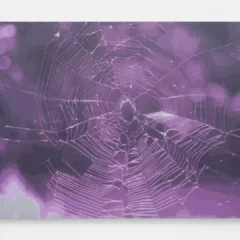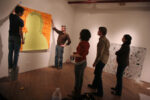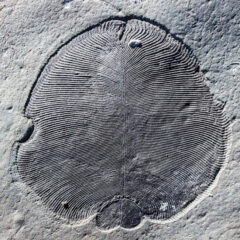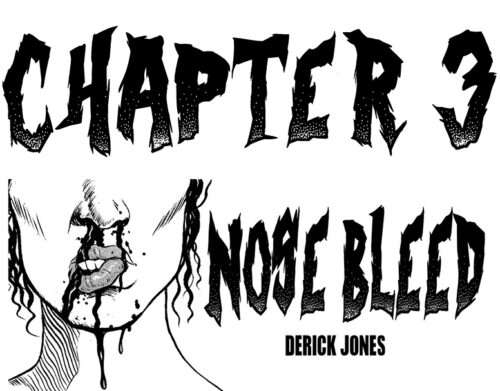—Chip deconstructs some perplexing work that deals with corporate logos, cat conundrums and cross-cutural cartoons. A fun show of absurdist humor. –the artblog editors———————————–Tiger Strikes Asteroid takes a foray into an ambivalent and over-saturated world in its April exhibition “Style Points and Substance Pangs” curated by Rachel LaBine and Keith J. Varadi. Three artists have work in the show: Jamian Juliano Villani, Emily Ludwig Shaffer, and Edward Marshall Shenk, and the work is, at times, difficult to find an entry point into, but when there is a way in, the images likely leave the viewer even more perplexed than when they set foot in the gallery.
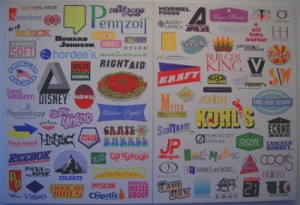
Shopping mall logos tweaked and out of context
Edward Marshall Shenk’s blandly titled “Diptych” is anything but blasé. Upon entering the gallery, these two canvases stand out as the largest work and the clear centerpiece. One is immediately submerged in a sea of logos and branding not unlike a casual stroll through a shopping district or a brief jaunt onto a retail website. Where Shenk’s work differs is that all of the brands are detached from their actual designs and mixed up with other brands’ designs and colors. It becomes somewhat of a game trying to match the brand names with their actual visual cues.
After a short time, however, it becomes clear that we tend to recognize far more of these companies and products than we expected or even cared to – even when they are mismatched.
Are any of these logos original or are they all just products of the artist’s imagination? Is it even possible to tell, and if so, why exactly does it matter? Just how much of our everyday brainpower is utilized for viewing, processing, and remembering brands and advertisements? While this game of match-the-ads is entertaining, it also provides us with some profoundly disturbing revelations about the nature of how things are sold to us each and every day.
Elsewhere, Shenk presents two original prints applied to the outsides of ‘magic’ coffee mugs sitting on a hot plate. Entitled “Communion,” this piece allows for little formal analysis except for one mug with cartoon pants and shirts applied to what looks like a hardcore pornography scene. These additions presumably appear and disappear with heating like some type of perverted transubstantiation.
Feline mysteries and Shrodinger’s cat
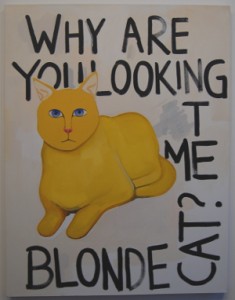
Also a bit concerning, but also smacked with absurdist humor, is Emily Ludwig Shaffer’s pair of paintings. Both are entitled “You Know” and each pose the same question: “Why are you looking at me blonde cat?” On each canvas the form of a yellow cat is the clear focal point, the words of the (rhetorical?) question float around and behind its shape. One of the animals is only a splotchy, cat-shaped blob, and in the other painting, some of the letters are whited out; neither piece seems complete.
We keep felines in our houses and they stare at our utterly alien activities with their large, slit-pupil eyes. Surely no one is positive why the blonde cat looks on, but the artist tells us we do anyway.
Perhaps these paintings are merely Cheshire Cat tautologies lending themselves to an “it is what it is” mentality. After all, while the old adage is that curiosity kills the cat, in this case the results seem more Schrodinger than anything else. The blonde cat is looking and the blond cat is not looking. You know.

Jamian Juliano-Villani presents some of the more vexing work in the show (if that is possible) with her two paintings “New Peking” and “Third World.” These scenes are reminiscent of East Asian prints from ancient China or Japan, but exist as obnoxiously bright renditions of what would otherwise be serene snippets of history. Most of his figures are extremely comical, illustrated with gigantic noses and anatomically incorrect blobs of bodies. Booze is poured from on high into waiting mouths in “Third World,” and lines of dominoes wait to be kicked over in what can only be described as an orgiastic setting. In “New Peking,” a pair of surreal, giant hands form shadow animals behind a drinking couple, the woman’s breasts in full view. Post-coital sake, anyone?
Don’t expect to come away understanding much in “Style Points and Substance Pangs,” but don’t be afraid to accept unknowing either. This show seems to revel in its obtuseness and if anything, it encourages everyone else to, too.



